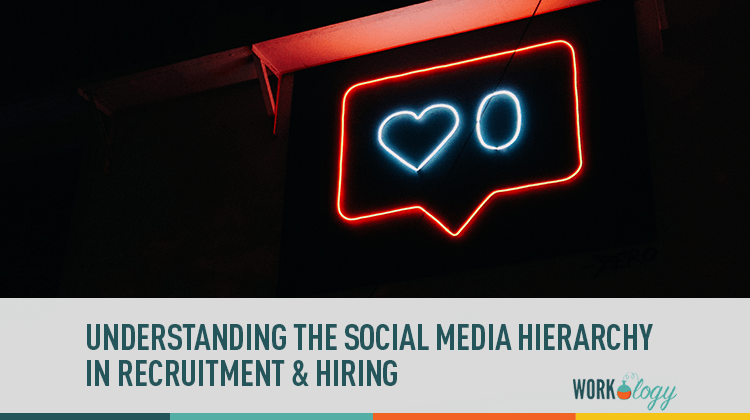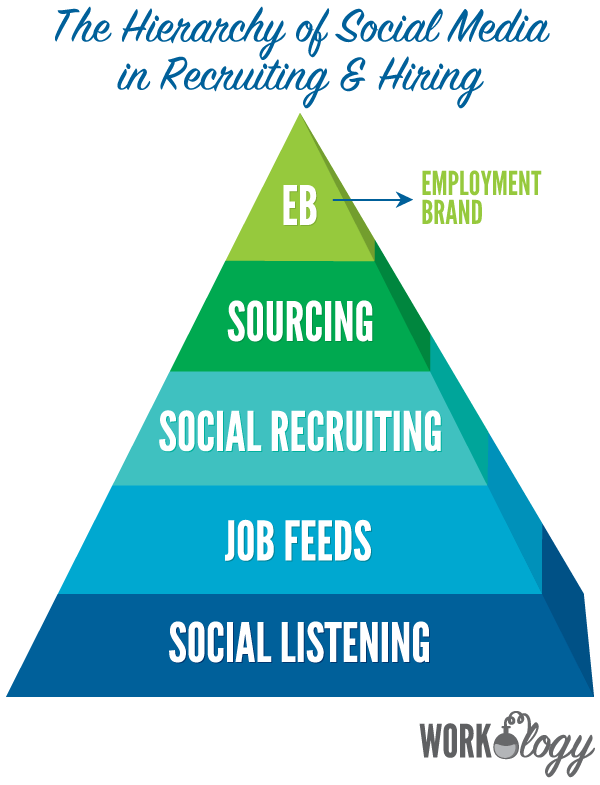Social media, in my opinion, is the most misunderstood, popular tool, and candidate resource used by recruiters to date. Social media provides recruiters and hiring managers the opportunity to access an active candidate’s news, information and resources about themselves in real time. These potential job seekers may not be active in the sense of actively seeking work but in the market occasionally dipping their toes in the water. As recruiters and hiring managers, we are watching them just the same. The information they share, however, is available to nearly anyone providing a timeline of interests, comments, events and a stream of conscious for those with good intentions as well as bad.
In my mind, there are five distinct levels of activity when it comes to using social media for hiring and recruiting. Recruiting teams and companies climb along a social recruiting evolutionary scale as their recruiting strategies become more complex and defined. It’s not to say that one or more of the hierarchy levels are more effective for they serve different purposes depending on where you are with your organization’s overall recruiting strategy. This is not unlike the HR ROI Scale in relation to HR metrics I mentioned from Paul Kearns previously.
Just like Maslow’s Hierarchy of Needs, you need to satisfy a more functional and basic needs at lower levels to move further along the social media recruiting and hiring path. Sometimes the reason for this is based on the company’s comfort level when it comes to using technology, a lack of understanding about social media and candidate engagement online or budgetary concerns. Whatever the reason, a foundational understanding must be developed and ROI must be developed before a program or pilot is fully integrated into a corporate recruiting strategy. Sometimes for disruption and movement to happen along the hierarchy, this sometimes involves a rogue recruiter using social media without corporate permission for recruiting and engagement purposes in order to establish a baseline of success. Through experimentation, support from a key level of upper management and measurable success, companies can quickly move up the scale but not always.
How to Use Social Media in Recruitment and Hiring
Social Listening. We must listen, absorb and learn before we begin dipping our toes in the social media waters. We only have one chance to make an entrance so we must seize the opportunity. It’s important to understand the players, the competition and different ways job seekers as well as employers are currently using these tools. The first level usually involves monitoring actively of employees and candidates becoming aware of the conversations taking place and the reality that these are happening whether your organization or recruiting team is engaged or not.
Job Feeds. This is often the simplest method of leveraging social media for the purposes of broadcasting jobs and openings. It’s fully automated. As job postings are published on your career site, a job feed is distributed to social media sites like Twitter, Facebook and LinkedIn. These feeds are often customized with hash tags on Twitter to gain maximum exposure with those who are using these sites as search engines for news, information and resources by topic, keywords or hash tag.
Social Recruiting. A more interactive strategy that incorporates using tools to engage job seekers on sites like Twitter, Facebook and even LinkedIn. Recruiting teams use job feeds and some automation but the focus is on building relationships, answering questions and providing resources to job seekers driving applicant traffic to their company careers page. Recruiting teams respond to job seekers, provide resources and share best practices with the hope of driving candidates to job openings. Careeer sites begin to be render for mobile devices. The strategy is more complex and involves multiple channels and social accounts often a full time employee or subject matter expert within recruiting who understands how to use social media and marketing.
Sourcing. Social media has brought about an new importance in internet and social media sourcing. As professionals flock to social media sites to engage, share and talk shop, sourcers can use the information they provide as an internet playground in which to snatch top talent long before they update their resume on a job board or even their LinkedIn profile. To be a strategic internet sourcer that leverages social media in hiring, they are looking at directories, Twitter hash tags and other recruiting hacks, online communities while creating their own talent community or pool in which to engage job seekers without relying strictly on resume mining in a more traditional sense on LinkedIn and other resume storage communities like Monster, CareerBuilder and Indeed. True sourcers go beyond the standard email and truly engage the prospective employee.
Employment Brand. This is a new breed of marketing and the most advanced form of social recruiting with the candidate in mind. Companies are flocking to sites like Twitter, Facebook,recruiting videos and even Pinterest to build their brand as a growing number of job seekers that apply for positions are using social media, mobile and peer networks online to help select the company they want to work for. Recruiting teams are building robust branding and engagement strategies seeing candidates not only as potential customers for the products they sell, but advocates for their brand and future employees. This is the definition of employer brand. Mobile plays a large role in their strategies with relation to recruiting and employment brand as companies become more competitive and creative to reach the competitive candidate market. Marketers with proven experience are overseeing branding and execution in recruiting. Larger organizations like Taco Bell, PepsiCo and AT&T are thinking this way. However, the market is still relatively new and smaller companies can take advantage and still be seen as an early adopter.
This is a several part series that looks in depth at social media recruitment and hiring strategies for recruiting and HR. Click here to read part 2 of the series.











Comments are closed.